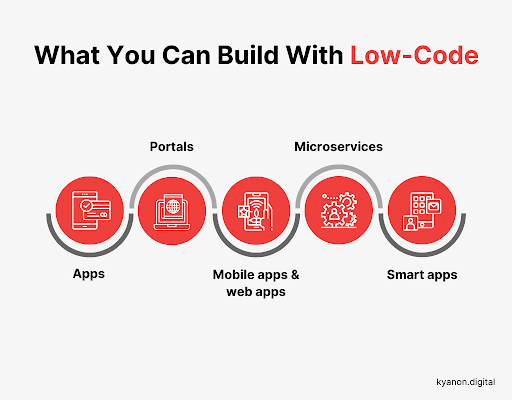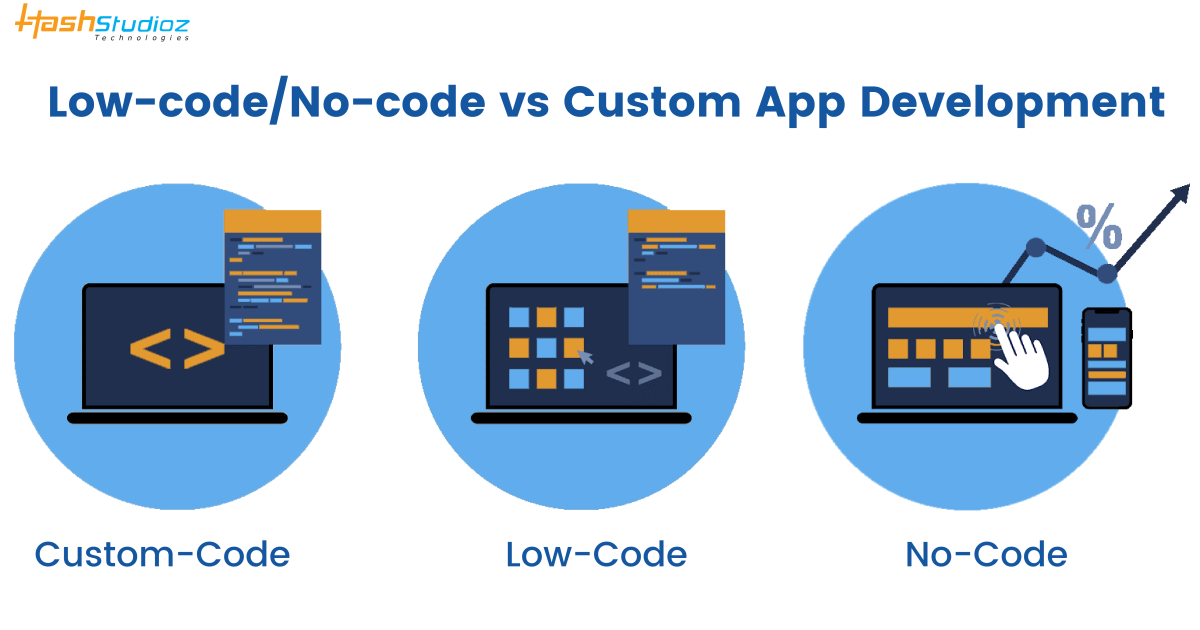Top Info On Choosing Low-code platforms for application development
Top Info On Choosing Low-code platforms for application development
Blog Article
In Terms Of SpeedLow-Code Software Offers A Variety Of Advantages.
Visual Development Environment:
Drag-and-Drop Interfaces: Low-code platforms provide visual tools for designing applications. Developers can easily build an application using drag-and-drop elements without having to write code.
Pre-built Templates and Components: A number of low-code platforms include pre-built templates and components, which enable developers to swiftly create and prototype applications without starting from the beginning.
Reducing Coding requirements
Automated Code Generating: The low-code platform generates the code underneath based upon the visual models that developers design. This eliminates the need for manual code coding.
Reusable Components : Developers can reuse components in different projects, thereby reducing the amount of time needed to write and testing codes.
Streamlined Collaboration:
Low-code platform tools typically include versions control, testing deployment. This allows for the seamless communication between teams.
Development by citizens: Using user-friendly interfaces and reducing bottlenecks often caused by the limited availability of business users, developers and non-developers are able to contribute towards application development.
Rapid Iteration, Prototyping
Fast Prototyping. Developers can build prototypes quickly to validate their ideas and get feedback. This can lead to a more efficient iteration.
Easy Modifications – The visual nature of low-code applications allows easy updates and changes that speed the process of refining applications based upon user feedback.
Pre-built Integrations:
API Integrations - Low-code platforms come with prebuilt connectors that are compatible with APIs or services that are popular. They can speed up the process it takes to integrate external applications.
Data Integration: Built-in tools for data-integration simplify the connection to databases and other data sources. This speeds up development.
Deployment Scaling
One-Click-Deployment: A lot of Low-Code platforms have one-click option for deployment. This can reduce the time and effort needed to set up an application.
Cloud-based solution: Cloud based low code platforms can handle the management of infrastructure and scale. This lets developers concentrate more on the application logic, functionality and features instead of deployment logistics.
All in all, low-code development offers advantages in terms of speed due to its ability to automate and simplify many elements of development. This allows for faster delivery of apps and easier adapting to the changing demands. See the most popular discover more here on Low-code Platform for application development for site info including app dev platform, app development platform, low code platforms, develop cross platform mobile app, rapid application design, azure sql databases, ms azure sql, low code platforms, azure sql server, app development platform and more.
Low-Code Development's Cost-Effectiveness Is Among The Major Benefits.
Low-code application development has numerous advantages in terms of cost-effectiveness and efficiency, which makes it an appealing choice for companies looking to maximize their development budgets while still delivering top-quality software. These are the main advantages reduced development costs:
Reduced Coding: Low-code platforms minimize the amount of hand-coding required and saves developers time and energy in the process of creating applications. It also means lower costs for labor.
We require fewer developer resources. Low-code development takes shorter time, and it is simpler. This means fewer developers are required. This will drastically lower costs for hiring and staffing.
More rapid time to market
Accelerated Development Cycle: Visual development tools and pre-built parts offered by low-code platforms allow for rapid development of applications, which allows businesses to bring products to market quicker. This could lead to quicker revenue generation and better competitive positioning.
Rapid Prototyping. Businesses can test quickly and develop prototypes. This reduces time spent in the development process and enables quicker iterations based on feedback from users.
Low Maintenance Costs
Simpler maintenance: Low-code platforms, with their modular components and standardised components, are easier to maintain. It helps reduce the cost of maintenance and support.
Automated Updates: A lot of low-code platforms handle patches and updates in a way that is automatic, ensuring applications remain secure and up-to-date, without the need for large manual intervention.
Efficient Resource Utilization:
Contributions from non-developers Low-code platforms permit people who are not developers to participate in the process of development. This decentralization of development enables businesses to leverage the skills of a wider range of employees, while reducing dependence on high-paying developers.
Improved Utilization of IT Resources: IT departments are able to concentrate on more strategic projects instead of getting bogged down with mundane development tasks which can increase overall productivity and efficiency.
The Scalable Pricing models
Subscription pricing: Many low-code platforms offer different subscription pricing options that can be scaled according to usage. This allows business to be able to align their spending with the actual demands and growth while avoiding large upfront costs.
Pay-Asyou-Go Options Certain platforms allow companies to pay for only the amount they spend. This is especially beneficial for startups or small companies with limited funds.
Reduce the cost of third-party software:
Built-in Functionalities: Low-code platforms typically come with built-in functions and integrations that eliminate the requirement for third-party software and tools, resulting in cost savings on software licensing and subscription fees.
Pre-Built Intergrations: The ability to use pre-built integrations and pre-built integrations for popular applications and systems reduces the need for custom development and saves time and money.
Better ROI
Faster Return on Invest Rapid development: By combining less expense and a shorter speed to market, companies are able to get a higher ROI on their investment (ROI).
Enhanced agility. Companies can adapt quickly to the changing market conditions and customer requirements. This will allow them to remain relevant, and they are able to take advantage of new opportunities.
Lower Cost of Training
Low-Code Platforms Have User-Friendly Interfaces. The intuitive and user-friendly interfaces help ease the learning curve of novice users. This eliminates the need for intense training programs.
Accessible resources Low-code platforms often have extensive tutorials, training materials, and community assistance, reducing the requirement for formal instruction.
Collaboration Streamlined:
Enhanced Collaboration Tools: Inbuilt tools for collaboration help improve communication and coordination between team members, resulting in more efficient development processes and a reduction in project costs.
Unified Development Environment (UDE): A single, unified development environment simplifies workflows and reduces the costs and complexity of managing various tools and platforms.
Overall, the efficiency of low-code software development is due to its capability to cut down on the cost of maintenance and development, increase time to markets as well as optimize the use of resources and provide flexible price models. These elements provide huge financial rewards to businesses. Low-code development is an excellent choice for organizations that want to make the most of their budgets, but also build robust, scalable, and high-quality software. Have a look at the top Legacy application modernization with Low-code hints for more tips including database in azure, rapid action development, sso azure, mobile app development platforms, build with docker, driver jdbc, app dev platform, mobile development platforms, azure sql databases, lowcode no code and more.
Advantages Of Low-Code Application Development In Terms Of Limitations And The Possibility Of Customizing
Low-code application development is a well-balanced solution that has significant advantages in addressing limitations while permitting customization. These are the key advantages: Managing the limitations
Resolving Complexity:
Low-code development platforms are easier to use because they provide already-built components, templates as well as other tools. They also permit quicker deployment of even complex applications.
Guided Workflows: Many platforms provide guided workflows and wizards to assist developers in navigating through the maze of processes, decreasing the likelihood of errors and making sure that the process is consistent.
Scalability Solutions:
Scalability built-in: Low-code platforms are often equipped with features that enable an scalable architecture. This lets applications take on more load without massive re-development.
Performance Monitoring: The tools which monitor and optimize performance can help ensure that applications are efficient even as they expand.
Security and Compliance
Integrated security features of Low-code come with built-in measures of security, such as encryption. Access control based on role and automated compliance check, addressing the most common security issues.
Regular updates: Platforms regularly upgrade their security protocols and compliance policies. This ensures applications remain safe from threats that are constantly evolving.
Customization Options:
Extensibility:
Custom Code Integration : Low-code platforms typically allow for the integration of custom code (e.g. JavaScript, Python) which enables developers to enhance the capabilities beyond the standard offerings.
Developers can add extensions or modules to meet specific business needs.
APIs Integration:
API Support: Full API support is available to enable seamless integration and communication to external systems.
Third-Party Services: Low-code platforms often provide pre-built connectors for popular third-party services, making it simpler to integrate and customize applications.
Flexible UI/UX Design:
Customizable User Interfaces: Designers can modify and create user interfaces that are in line with the specifications for branding and usability and create a customized user experience.
Responsive design: The capability to customize applications for different devices and screens is built-in.
Making Business Logic more flexible is simple:
Visual Workflow Builders - Visual tools used to design and customize workflows, business logic and processes allow developers to design complicated and customized processes without lengthy programming.
Conditional Logic & scripting: Platforms permit the application of conditional logic and custom scripting to manage specific business rules.
Data Management
Custom Data Models: Developers are able to design a custom data model to meet specific application requirements and ensure that data handling is in line with the requirements of business.
Advanced Data processing Integration and advanced data handling tools allow for the customisation of data analysis and usage in the program.
How do you balance personalisation and restrictions:
Frameworks and Standards
Low-code platforms encourage the use of industry-standards and best practices, resulting in applications of high-quality that are robust and safe.
Governance Frameworks - Built-in governance frameworks make sure that any modifications do not interfere with security, integrity or the observance of regulations.
Iterative Development and Feedback:
Rapid Prototyping : Developers can quickly test their customizations and prototypes based on the feedback of users, enhancing the application based on their needs.
Low-code platforms have been designed to support continual improvement. This permits for modifications and enhancements as business requirements evolve.
User Empowerment
Low-code platforms enable citizen developers by allowing non-developers with intuitive interfaces, to personalize applications, they increase the pool of developers who can enhance and tailor apps.
Training and Support A lot of platforms offer comprehensive training and resources to support users as they customize their apps, without compromising its stability or performance.
Overall, Low-code application creation gives you a framework that's robust and adaptable enough to meet restrictions while allowing ample customization. This balance allows companies to build and maintain apps that work and tailored to specific business needs. All while maintaining security, quality as well as scalability and standards.